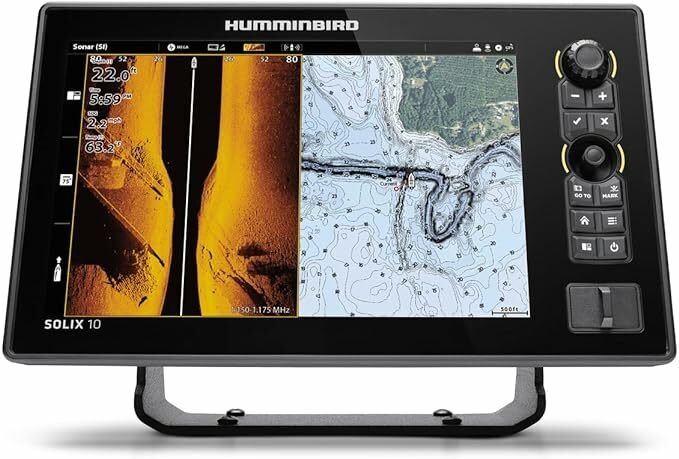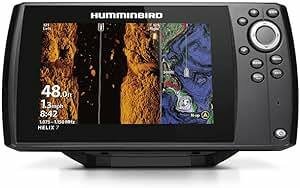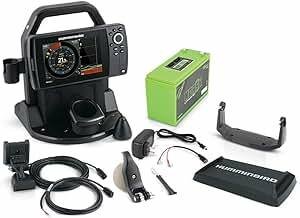What is a sonar?
A sonar, also known as a fish finder, is a device that uses sound waves to locate fish underwater. The device emits a sound wave that travels through the water and bounces off of objects, including fish. The sound waves are then received by a transducer, which converts them into electrical signals. These signals are then displayed on a screen, which allows the user to see where the fish are located.
Sonars are used by fishermen to locate fish so that they can know where to cast their line. They are also used by scientists to study fish behavior and by the military to locate submarines.
Sonars work best in waters that are shallow and clear. Objects in deep or murky waters can scatter the sound waves, making it difficult to get an accurate reading.
There are two main types of sonars: active and passive. Active sonars emit a sound wave and then listen for the return signal. This type of sonar is used by the military to locate submerged objects. Passive sonars listen for sounds that are already present in the water, such as the sounds made by fish. This type of sonar is used by fisherman to locate fish.
What can a fish finder do?
A fish finder is a tool used by anglers to locate fish underwater. A fish finder uses sonar technology to detect the presence of fish. Fish finders can be used in both fresh and salt water.
Fish finders work by emitting sound waves into the water. These sound waves bounce off of objects in the water, including fish. The fish finder then detects these reflected sound waves and uses them to create a map of the underwater environment.
Fish finders can be used to locate fish that are hiding in structures such as reefs or shipwrecks. They can also be used to find schools of fish or to determine the depth of the water.
Fish finders are an essential tool for serious anglers. They can help anglers locate fish that would otherwise be difficult to find.
How do you use a fish finder?
If you’re new to fishing, the idea of using a fish finder can be daunting. After all, there’s a lot of technology packed into these little devices! But never fear – using a fish finder is actually pretty straightforward, and once you get the hang of it you’ll be an expert in no time. In this blog post, we’ll take you through everything you need to know about using a fish finder, from what all the different buttons do to how to actually interpret the data on the screen.
Before we get started, it’s worth mentioning that there are different types of fish finder available on the market. Some are designed for use in freshwater, while others are better suited to saltwater fishing. Make sure you buy the right one for your needs!
Now let’s take a look at how to use a fish finder. The first thing you need to do is attach the transducer to the bottom of your boat. This is the part of the device that actually sends out the sonar pulses and receives the echoes, so it needs to be in the water in order to work properly. Once the transducer is in place, power on your fish finder and wait for it to initialize.
Once it’s up and running, you’ll see a display on the screen showing different information. The most important thing to look at is the depth finder, which will show you how deep the water is beneath your boat. This is important to know so that you can avoid running aground!
You’ll also see a fish icon on the display. This shows you where the fish are swimming in relation to your boat. The closer the fish are to the transducer, the higher up on the screen they will appear.
Some fish finders also have GPS capabilities, which can be really useful if you’re planning on fishing in a particular spot again in the future. GPS can also be used to create maps of your favorite fishing spots, which is handy for sharing with other anglers.
Is a fish finder worth it?
If you’re an avid fisherman, then you know that one of the most important pieces of equipment you can have is a fish finder. But what is a fish finder and is it really worth the investment?
A fish finder is a device that uses sonar to detect fish in the water. It works by sending out a sound wave that bounces off of objects in the water and then back to the fish finder. The fish finder then uses this information to determine how deep the water is and whether or not there are any fish in the area.
So, is a fish finder worth it? Absolutely! Having a good fish finder can make all the difference in your fishing success. Not only will it help you find fish, but it will also help you determine the best way to catch them. If you’re serious about fishing, then a fish finder is a must-have piece of equipment.
Where should you mount a fish finder?
There are a few things you need to consider when deciding where to mount a fish finder on your boat. The first is how you will be using your fish finder. Are you going to be trolling, bottom fishing, or using it for both? If you’re going to be doing a lot of trolling, you’ll want to mount the fish finder near the back of the boat so you can see the transducer as it’s pulled through the water. If you’re going to be bottom fishing, you’ll want to mount it near the front of the boat so you can see the transducer as it’s lowered into the water.
The second thing you need to consider is where you will have the clearest view of the screen. You don’t want to mount the fish finder in a place where it will be difficult to see the screen or where the sun will wash out the screen.
The third thing you need to consider is how you will be wiring the fish finder. You’ll need to have a power source for the fish finder and you’ll need to run the wires from the fish finder to that power source. It’s best to mount the fish finder near the power source and to run the wires through a conduit so they are protected from the elements.
Once you’ve considered how you’ll be using your fish finder and where you’ll have the clearest view of the screen, you can start thinking about where to actually mount the fish finder on your boat. The most important thing is to make sure that the transducer is mounted in a place where it will not hit anything when the boat is in motion.
If you’re mounting the fish finder near the front of the boat, you can mount it on the dash, on the console, or on a pedestal. If you’re mounting it near the back of the boat, you can mount it on the dash, on the transom, or on a swim platform.
Top 5 Fish Finders of 2023
DISCLAIMER: The links I mention may be affiliate links. If you purchase through one of these links I may receive a commission, at no cost to you. As an Amazon Associate I earn from qualifying purchases.
Best Overall: Garmin ECHOMAP UHD 93sv

The Garmin ECHOMAP UHD 93sv is a top-of-the-line marine GPS chartplotter that comes preloaded with GN+ U.S. lake maps and a GT54UHD transducer.
This chartplotter is packed with features that any serious boater or fisherman will appreciate. The high-definition 9-inch display is sunlight readable and provides excellent detail when viewing maps or nautical charts. The built-in garmin sonar functions allow you to see what’s beneath your boat in real time, and the included transducer provides ultra-clear HD-ID sonar and downvu/sidevu scanning.
The ECHOMAP UHD 93sv also comes equipped with a powerful 600-watt Garmin HD-ID sonar system that can penetrate up to 3000 feet of water. This sonar system is incredibly accurate and provides fish size estimations, as well as the ability to see fish and structure in 3D.
Pros:
1. Preloaded with G.N+ U.S. Lake Maps
2. Excellent battery life
Cons:
1. Overly sensitive touchscreen
Humminbird SOLIX 10 Chirp

The Humminbird 411530-1 SOLIX 10 Chirp MEGA SI+ G3 is one of the latest and greatest fish finders on the market. If you’re serious about fishing, then this is the device for you. It comes packed with features that will help you find and catch more fish, including CHIRP sonar, Mega Side Imaging, GPS mapping, and more.
The SOLIX 10 is easy to use and comes with a clear and bright 10-inch display. It’s also very durable, so you don’t have to worry about it getting damaged if you take it out on the boat. The only downside is that it’s a bit pricey, but it’s worth the investment if you’re serious about fishing.
Pros:
1. Excellent side imaging
2. Excellent down imaging
3. Low noise
Cons:
1. May not work with all transducers
2. Expensive
Best Budget: Humminbird Helix 7

The Humminbird 411590-1 Helix 7 Chirp SI GPS G4 Fish Finder is a great product for anyone who loves to fish. It is very easy to use and has all the features that you need in a fish finder. The display is very clear and easy to read, even in direct sunlight. The GPS feature is very accurate and the transducer is very sensitive, so you can always find the fish. The only downside to this product is that it is a bit pricey, but it is definitely worth the money.
Pros:
1. Clear side imaging
2. Excellent shadow coverage
3. Affordable
Cons:
1. Lakemaster not included
Best For Kayaks: Lowrance Elite FS 9

The Lowrance Elite FS 9 Fish Finder is one of the best on the market. It is packed with features and comes with a transducer and pre-loaded C-MAP contour+ charts. The Elite FS 9 is perfect for anglers of all levels.
The Active Imaging 3-in-1 transducer is a top-of-the-line feature that allows you to see fish, structure, and bottom contours with amazing clarity. The Preloaded C-MAP contour+ charts are another great feature that gives you the ability to see bathymetric contours of your favorite fishing spots.
The Lowrance Elite FS 9 Fish Finder is the perfect choice for anglers of all levels. It is packed with features and comes with a transducer and pre-loaded C-MAP contour+ charts. The Active Imaging 3-in-1 transducer and Preloaded C-MAP contour+ charts are two of the best features that set this fish finder apart from the competition.
Pros:
1. Excellent sonar
2. Responsive touchscreen
Cons:
1. Waypoints can only be transferred via Ethernet
Humminbird ICE Helix 7 Chirp

If you’re in the market for a new fish finder, you’ll want to check out the Humminbird 411760-1 ICE Helix 7 Chirp GPS G4 All Season. This state-of-the-art fish finder is packed with features that will make your fishing trips more productive.
One of the most impressive features of the Humminbird 411760-1 is the Chirp technology. This technology sends out a continuous sweep of frequencies, which allows you to get a more detailed view of what’s below the surface. The Chirp technology also makes it easier to find fish, because you can see them more clearly.
Another great feature of the Humminbird 411760-1 is the GPS capabilities. With the built-in GPS, you’ll be able to track your position, as well as create waypoints. You can also use the GPS to find fishing hotspots.
The Humminbird 411760-1 also has a large, 7-inch display. This makes it easy to see what’s going on below the surface. The display is also LED backlit, so you can see it even in direct sunlight
Pros:
1. Great sonar
2. Includes transom mount and power adaptor
3. Excellent screen brightness
4. Great battery life
Cons:
1. 1 year limited warranty
Looking For More Gear?
Check out our other articles and reviews on the best fishing gear
